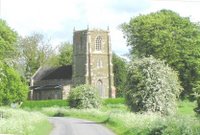Either way, settlement patterns - Iron Age, Roman and Medieval - confirm the varying outlines of the coast and man's attempts to work new land and to stem the tide. A distribution map taken from the Domesday Book of 1086 shows much the same pattern of villages as one drawn up today. And, as a rule of thumb, the size of a parish church as it relates to its village now is much the same as it was when it was built - showing that we haven't spread ourselves about much for a thousand years and the reason for some places being more desirable and prosperous than others is the same now as it was back then.
Things have changed over the last few decades. Changed patterns of rural employment mean that ambitious local youngsters move to other areas of the UK for work. The vacuum is filled by older people coming in - people escaping from crime-ridden, multicultural, chav-infested cities and bringing with them capital and pension incomes not earned in the local economy. Instead of stretching boundaries to make extra opportunities, the emphasis is on preservation of what was put here by previous generations. Our landscape and landmarks were functional to the times when they were created. Now they exist almost independently of their original purpose and their value is in the contribution they make to the attractiveness of the area.
 This church has seen the sea lap at its foundations and recede again. It has survived the Black Death, the Reformation, the Civil War, the Iconoclasts and competition from the Non-conformists. In its Victorian hey-day, it would have held three services every Sunday as well as Masses during the week. Previous vicars lived in some style at the rambling vicarage nearby. One of them is commemorated in the glorious stained-glass East window and a lavish brass plaque records him leaving the Parish to become Bishop of Zanzibar.
This church has seen the sea lap at its foundations and recede again. It has survived the Black Death, the Reformation, the Civil War, the Iconoclasts and competition from the Non-conformists. In its Victorian hey-day, it would have held three services every Sunday as well as Masses during the week. Previous vicars lived in some style at the rambling vicarage nearby. One of them is commemorated in the glorious stained-glass East window and a lavish brass plaque records him leaving the Parish to become Bishop of Zanzibar.Nowadays, the present incumbent is based in Spilsby and has ten such churches in his charge. Services are held twice a month for a dwindling band of, mostly, elderly widows.
How much longer can the church hold out? How long before this entire area goes the same way - or completely becomes a living-museum?
No comments:
Post a Comment